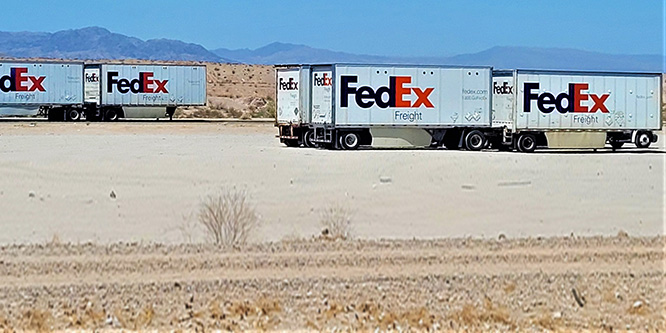
Photo: @AZ.BLT via Twenty20
October 19, 2021
Get ready for the ‘IOU Christmas’
This is what happens when the shipping container crisis meets Shipageddon. We are all experiencing the supply chain crisis together — delays at ports, skyrocketing container costs and supplier delays. What should retailers do in the face of all these challenges?
While the big decisions like merchandise, pricing and promotions are all done, there are last-minute adjustments that retailers can make as we head into the holiday season.
First, start with communication. If you have reduced inventory and your conversion rate is down, talk to your customers about it. Don’t pretend they won’t notice.
Second, pay close attention to your delivery SLAs by carrier and service level. Why? Because while Amazon.com, FedEx, Target, Kohl’s and Walmart are recruiting over half a million workers combined for holiday, it’s not likely they will be able to hire at these levels in time — meaning your delivery times are going to get worse.
In FedEx’s recent earnings call, it was announced that the company is routing over 600,000 packages a day around certain nodes in its network due to staffing challenges. And that’s before the holiday season.
If you are promising a delivery date to your consumer today, add a few more notifications throughout the journey to provide visibility and reduce your customer service workload. Do not let two days go by without a new update.
Third, inventory alerts on out-of-stock products and brands are now table stakes. Allow your consumers to tell you they are looking for items you may not have, and let them know via email or SMS immediately when these return to stock. Since these challenges are affecting everyone, your best bet is to make it easier for your consumers than your competition does.
Fourth, tweak your product pages to show data freshness. In an environment where scarcity is common, the retailers that communicate inventory positions with accuracy will be the winners. Every brand should state when inventory data was last refreshed on their product pages. Tell a story about it.
Finally, consider offering giftable subscriptions. One way to smooth out supply chain demand is to convert one big purchase at Christmas for a friend and spread it out into four smaller quarterly gifts over the course of next year.
In summary, the two big areas I would think about are communication, along with establishing a longer-term relationship with your consumer beyond this holiday. How about you?
Discussion Questions
DISCUSSION QUESTIONS: How well prepared are retailers to deal with the prospects of an IOU Christmas? What recommendations in the article do you think have particular merit, and are there any you would add?
Poll
BrainTrust
Gary Sankary
Retail Industry Strategy, Esri
Recent Discussions








It seems like retailers realize the reality of the supply chain issues and are taking measures to offset the impact such as stocking up now and even chartering private shipping containers. Consumers are reading about the supply chain issues in the news, but many are probably not realizing how much it may impact their holiday purchases. Consumers that want to ensure they have gifts to give during the holidays should shop now. Gifts of subscriptions services are also a good option, especially for those who don’t start shopping soon.
One theme that emerges from this article is to be proactive. Start planning and hiring now. In some cases, it may already be too late. Several thoughts come to mind. 1.) Retailers will need to be transparent about any delays the customer may experience. The “out of stock” alerts mentioned in the article is good example. 2.) Retailers need to get creative and help their customers with the gift IOUs. I bet we see some fun and innovative ideas coming from retailers. 3.) Retailers must keep customers updated with status. Customers love information and it helps them feel in control.
I am going to go out on a limb here and predict that the supply chain issues plaguing the retail industry today will have an unintended consequence much like pandemic has had on future store operations, and that is that retailers will realize that they can start the holiday selling season closer to the holiday itself. It is the demand that drives the sales, not the calendar.
It’s time to dust off the concept of “rain checks” which were common in old-time retail. What is old is new again. I was just asked what “IOU” stood for by a young associate, so we live in a Venmo world where these concepts are just old hat — you know, the thing we used to wear on our heads.
Is this the “Intel Inside” moment for supply chain visibility? Since the average shopper is now aware that most gifts will come from far away lands, retailers who have the capability to share “where are my gifts” info will be rewarded. Of course, this requires RFID technology implemented throughout the supply chain, so it’s only the usual suspects retailer who would be able to do this today. For everyone else, identifying and satisfying secondary demand (aka Plan B) purchases will be essential.
With an accent and the “old” part. Oh, those “Casablanca” days… 🙂
While supply chain issues are just being recognized by consumers, retailers have been aware of challenges for much longer. Planning for holiday season happens months in advance, and many retailers took extra measures to ensure they ordered early, found some sort of capacity and started building inventory earlier than usual. There certainly may be shortages or out-of-stocks here and there. Transparency will be critical. But the silver lining in this is that we may see record low levels of markdowns needed after the season if retailers sell through their inventory. We may see consumers shift to in-store shopping earlier (versus waiting until shipping windows close) which may also be a benefit to retailers.
Transparency is critical right now. Proactive communication with your customers will go a long way toward assuaging their frustrations when they can’t find what they’re looking for.
We are experiencing an unprecedented supply chain disruption and the situation is far more complex than we could imagine. Perhaps this disruption will lead to more conscious consumerism, where customers have to assess their individual place one Maslow’s hierarchy of needs. There are needs and there are wants.
Just as Gen Z embraces sustainability and transparency around sourcing, we all should be more targeted with our spending. Retailers will take a short-term hit. However this fundamental shift will fall in line with assortment curation, inventory optimization strategies, and being more prescriptive with their demand forecasting.
While this “new normal” remains unpredictable, the one constant we are seeing is the retail industry’s resilience, character, and determination to overcome these challenges and drive new operating models to meet the consumer’s needs.
Under normal circumstances, retailers would build their inventories to a peak just before Thanksgiving and would work their way through those peaks over the following six weeks (with some backflow on key items). Of course, these aren’t normal circumstances.
It’s getting late for stores to fix their inventory shortages, especially if they can’t predict whether shoppers are coming early (to avoid later stockouts) or spending later (to catch more incoming goods). One thing is certain: This is going to be a banner holiday for gift cards.
If I were a retailer in this unprecedented season of scarcity, any original plans I had about pricing and promotions would be in state of flux. If the original plan was to promote at 40 percent off, but my current on-hand/delivery situation would have me sell out, do I now promote at 25 percent off until late deliveries arrive? Seasonless product presents one kind of challenge. Seasonal apparel will be a nightmare in managing conversion from holiday to spring content. We can only hope that retailers are getting transparent communication from the shipping companies so they can be equally transparent with their customers.
The uneasiness that retailers are feeling about Holiday 2021 has not fully reached the consumer level. Consumers are aware of the situation but it hasn’t begun to hurt yet. It will when they begin shopping for specific gifts and cannot find them in stores or online. There will be plenty of substitutions and gift cards given as gifts this year. Gift cards are a positive because traditionally shoppers require more than one trip to the store to redeem their cards and spend more than the cards’ face value.
I have only received one email from a retailer regarding the difficulty in receiving new goods. It was from the CEO of Loft; it was open and honest and something I feel other retailers should do as well.
What if retailers got creative with the “layaway” concept? Allow shoppers to place orders now with a down payment (and incentivize them to do so) then ship it or alert the customer that it is in-store when it arrives? There would obviously be some logistics and accounting issues to consider, but it seems like a potential way to secure the sale.
Most retailers are on their heels this year, reacting to global factors they didn’t foresee or act on in time. Now they’re scrambling to minimize the financial costs and erosion of loyalty caused by product and labor shortages.
Proactive contingency plans include stockpiling warehouses with in-demand goods. Prompt communications can also protect consumer relationships. To minimize shoppers’ frustration, retailers can share frequent order status updates and immediate alerts once products are back in stock.
Success with this holiday season’s supply problems will depend entirely on the specific situation faced by a specific retailer. Thus these suggestions are interesting but not universal. It will be key that the retailer pay attention first and foremost, to exactly where they have challenges.
Incidentally, it is also critical that retailers not panic unnecessarily. This recent report from the AP shows that popular hype about shortages is being fed by false memes.
The supply chain problems that are quickly turning into a crisis will not be resolved until the trucking end of the supply chain process is fixed. Truckers need to be respected. Truckers need more time off as the job is a very hard one on the truckers and their families. Truckers need higher pay in order to attract and retain drivers. Unfortunately, virtually every product we consume is delivered via trucks and until there are more drivers the supply chain issues will remain and likely get worse. For reference: In pictures: Supply chain problems in the US – CNN
I’ll suggest a different outcome: “Experience” Christmas. Instead of giving a sweater, some people will give movie tickets or restaurant gift cards, which are never out of stock.
Excellent suggestion!
Simply brilliant!
I’m asking Santa for concert tickets this year!
How well prepared can retailers be when so much of the supply chain crisis is out of their control? Most consumers have already run into the “it’s the supply chain” excuse, so out-of-stocks aren’t going to come as much of a surprise. The best advice is to get ahead of the issue and assure shoppers they can get whatever they want when – and if – it’s available. All of the suggestions in the article are good, but none are an antidote for a disappointed child at the holidays.
We have been advising retailers to promote gift cards, with a 15 percent discount, which are not be valid until after Christmas. We read some time ago that a substantial number of cards are never redeemed. I know we would rather have the transactions, but those non-redeemed cards cover the discounts. Secondly, this will cause an increase in store traffic when the stores finally get some new items.
In addition to paying careful attention to carrier SLAs, retailers will need to watch their SLAs with drop ship vendors (DSVs) as well. From a consumer perspective it’s all part of the same retail experience yet retailers often have far less visibility into the status of DSV orders.
It will be interesting to see if the retailers who invested in a carrier diversification strategy this year (after delays last holiday season) will see it pay off, or if labor issues at regional carriers impact their SLAs as well.
Two points today:
First, communication is absolutely key in times like these but not just with your customers. Remember to communicate effectively with your store staff as they are the ones on the front line facing the customers. Too often retailers do not keep their store staff fully informed and give them the information they need to talk to customers. The store staff can save your business when a crunch hits like this. If they treat customers correctly, with knowledge and confidence in what they are saying and doing, it will go a long way to maintaining loyalty. If they get it wrong by over promising or not knowing what is going on customers will vote with their feet.
Second, when supply chains break down it is usually the smaller retailers that suffer most because they do not have the power to push their suppliers to treat them as a priority. The one advantage that small retailers do have is the closeness to the customer, the personal relationship that can talk to the customer and help them find alternatives, treating them like human beings. During the first lock down, when stocks were short, smaller independents performed very well. I am sure they will once again this time.
Perhaps one day soon we will take an enduring lesson from this year’s #shipocalypse: It’s perilous to focus the distribution system on one massive delivery peak even in a good year. Holiday shopping is certainly an important tradition, but it is not a law.
Rick’s advice regarding retailer planning and communications is on-target for the present season. Critical to that objective is absolute certainty about the location and timing of every item in inventory and in transit. Then be radically transparent about the status of every product you offer.
As Cathy points out, there can be a great advantage in emphasizing intangible gifts — like movie, music and video game downloads, concert, sports and show tickets, and passes for restaurant meals or amusement parks. None of these deliverables are hamstrung by shipping delays. Even better, they are front-loaded — get paid now, deliver later. Even returns are free from reverse logistics.
(My holiday wish list includes a one-year subscription to the AppleTV+ channel, MSRP $49.99. Wink. Wink.)
Retailers are experienced with managing out-of-stocks. This is not new. But, compounding the out of stocks are the holidays, COVID and panic buying. Few retailers will end the season in a better position than when they started. The best approach, as usual, will be customer first.
Retailers who keep the lines of communication open and who over deliver on their promises will win. Everyone will see out of stocks. But the old adage it’s true, consumers may not remember what was said about out of stocks but they will remember how you made them feel. Retailers should not miss this opportunity to foster relationships.
Transparency and open communication will be key. The old phrases “for a limited time only” and “limited stock on hand” may never be more true!